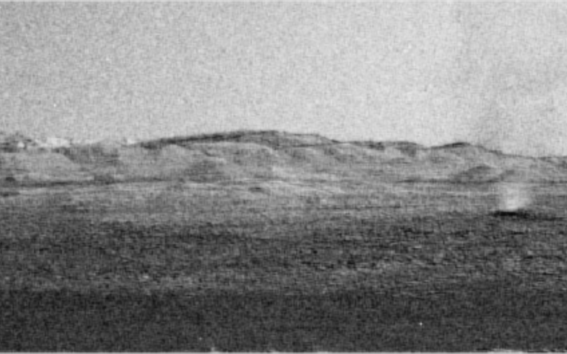On Mars the weather varies dramatically, however the planet’s climate is not changing

Mars, the fourth planet from the Sun, fascinates people in many ways. For atmospheric researchers it is an interesting subject as Mars is the most Earth-like planet of our solar system. Since 1976, probes landed on Mars have collected information on its dynamic weather phenomena.
In his doctoral dissertation at Aalto University, Henrik Kahanpää studied measurements of the atmospheric pressure on Mars, important not only for modelling the atmosphere of Mars but also for understanding the conditions of other planets.
‘The climate change has increased the need for modelling the atmosphere of the Earth. The ultimate test for verifying the validity of Earth's climate models is comparing them to models of another planet. Models of planetary atmospheres are also valuable in assessing the conditions of exoplanets found outside our solar system,’ says Kahanpää and admits that pure curiosity also inspired him to study Mars.
‘It is no coincidence that the rover sent to Mars by NASA in 2011 and still performing measurements there is called Curiosity.’
Finnish know-how for Mars measurements
Kahanpää's doctoral studies began while he was working at the Finnish Meteorological Institute. There he was involved in the development of the pressure instrument of the Curiosity rover.
The Finnish Meteorological Institute also provided a pressure instrument for NASA’s Phoenix probe which landed on Mars in 2008. These instruments are based on Barocap® sensor heads developed by the Finnish company Vaisala Oyj. Although these are the most accurate meteorological instruments sent outside the Earth, all measurements are affected by uncertainties, especially under harsh and unexpected conditions such as on Mars.
Kahanpää investigated uncertainty sources affecting these pressure measurements and developed correction algorithms to compensate for them. The results have been utilised in the development of the pressure instrument of NASA’s Perseverance rover operating currently on Mars. The dissertation showed that the surface atmospheric pressure of another celestial body can be measured with an accuracy of approximately 0.5% by these instruments.
'Comparison of the corrected pressure measurements of the Phoenix probe to the measurements of NASA’s Viking landers revealed that no measureable changes have taken place in the Martian climate between the 1970s and 2008'.
Dust devils
Lifting dust into the atmosphere, dust devils are important for the research of the Martian climate. They can have diameters exceeding one kilometre and be over ten kilometres high, although usually they are much smaller.
‘On Earth, weak dust devils spin autumn leaves on parking lots, while strong dust devils resemble tornados. In the thin air of Mars, dust devils are a more significant phenomenon as dust lifted from the planet’s surface has a huge impact on the atmospheric flows of Mars.’
Dust storms lift dust into the Martian atmosphere when the planet is closest to the Sun. However, the atmosphere is dusty also when Mars is farthest away from the Sun. Dust devils have been suspected to be the explanation. Kahanpää's research questions this prevailing perception.
‘I sought for signs of vortices in the weather measurements of Curiosity and found out that only a few of the vortices were strong enough to raise dust. Indeed, according to recent studies it seems that also other small-scale phenomena, such as slope winds, are able to lift a lot of dust into the Martian atmosphere.’
Information about the dust devils is important for the planning of future Mars landing sites as they significantly impact equipment on the planet’s surface. The dust devils can also be beneficial for Mars landers as they may clean up solar panels of probes. Because of this, NASA's rover Spirit survived on the surface for much longer than planned.
No thanks for a flight ticket to Mars!
In his doctoral dissertation, Kahanpää was able to fulfil his childhood dream of exploring the secrets of space.
‘What fascinates me about space is the idea that the universe is so large, and the Earth is so small. My enthusiasm for astronomy began as a child when my parents read me the book Comet in Moominland by Tove Jansson.’
The cover image of the doctoral thesis shows a whirlwind drawn by Jansson surrounding the Curiosity rover. According to the story, the whirlwind was caused by a comet barely passing the Earth.
Humans have already visited the Moon, and now both NASA and commercial companies are planning to take people to Mars and even to settle the planet permanently. Would the Mars researcher like to visit Mars?
"Absolutely not. No man should go to Mars. In my opinion, the Outer Space Treaty of the UN prohibits this, as it requires avoiding the harmful contamination of other celestial bodies. Mars should be declared a nature reserve.'
Kahanpää justifies his opinion by the impossibility of taking persons to Mars without taking their microbes with them, despite extensive protective equipment. The spread of life from Earth to Mars would lead to losing the opportunity to explore past or even present life on Mars.
According to Kahanpää, taking a person to Mars would be ethically wrong also with the traveller in mind.
‘The trip would be extremely unhealthy because it is impossible to completely protect a person against ionising radiation such as cosmic rays during the flight. Then, on Mars, the amount of UV radiation is enormous, and the soil contains perchlorate which is toxic to humans. I say to my children, “You can fly to the Moon, but not to Mars!”’
Text: Marjukka Puolakka
Read more news

DeployAI Partners Gather for Heart Beat Meeting in Helsinki
The European DeployAI project's partners gathered for the Heart Beat meeting hosted by Aalto University Executive Education in Helsinki.
Get to know us: Associate Professor Maria Sammalkorpi
Sammalkorpi received her doctorate from Helsinki University of Technology 2004. After her defence, she has worked as a researcher at the Universities of Princeton, Yale and Aalto.
Aalto computer scientists in ICML 2024
Computer scientists in ICML 2024